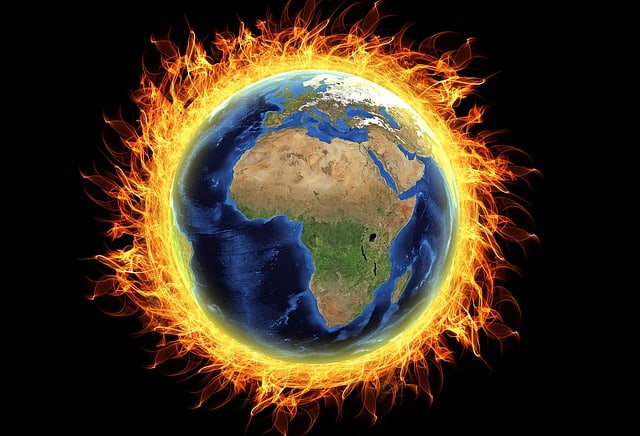July set to be the hottest month ever, courtesy climate change: Reports
With climate change triggering record-breaking temperatures, scientists have calculated that July is "virtually certain" to be the world's warmest month on record.
By Editorial Desk / Jul 28, 2023
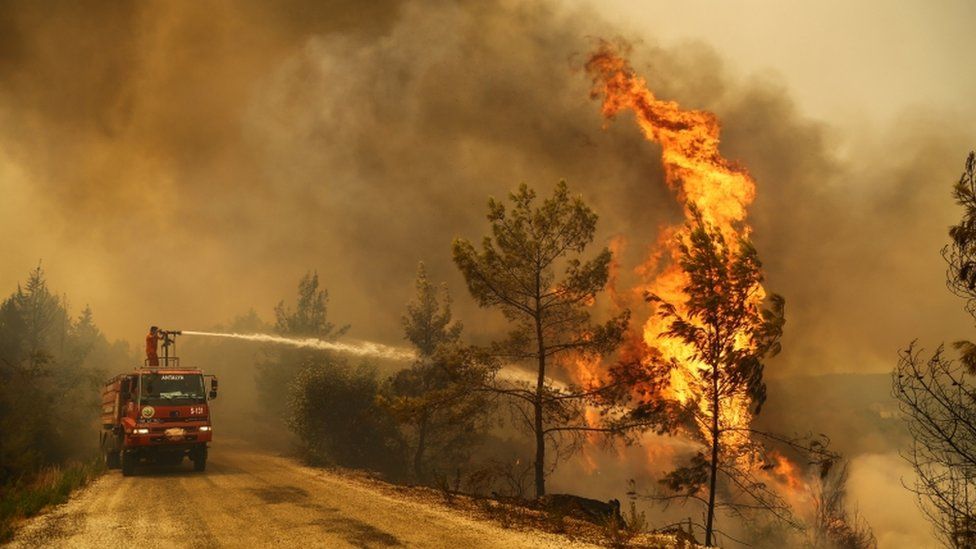
Image Courtesy: BBC
With record-breaking temperatures, scientists have calculated that July is "virtually certain" to be the world's warmest month on record. Even though there are a couple of days to go, researchers are confident that July is likely to be the warmest month human civilization has seen in the last 120,000 years.
According to an analysis by Dr Karsten Haustein, a climate scientist at Leipzig University, July 2023’s average global temperature is projected to be 1.3°C -1.7°C above the average July temperature before humans began warming the planet by burning fossil fuels.
The analysis found that the global average near-surface temperature in July will exceed the previous warmest July by a considerable margin. Using forecast data until the end of the month, the analysis found that July will be more than 0.2°C (+/- 0.1°C) warmer than July 2019, which is the current warmest.
The World Meteorological Organization (WMO) and the European Union’s Copernicus Climate Change Service have also drawn similar conclusions.
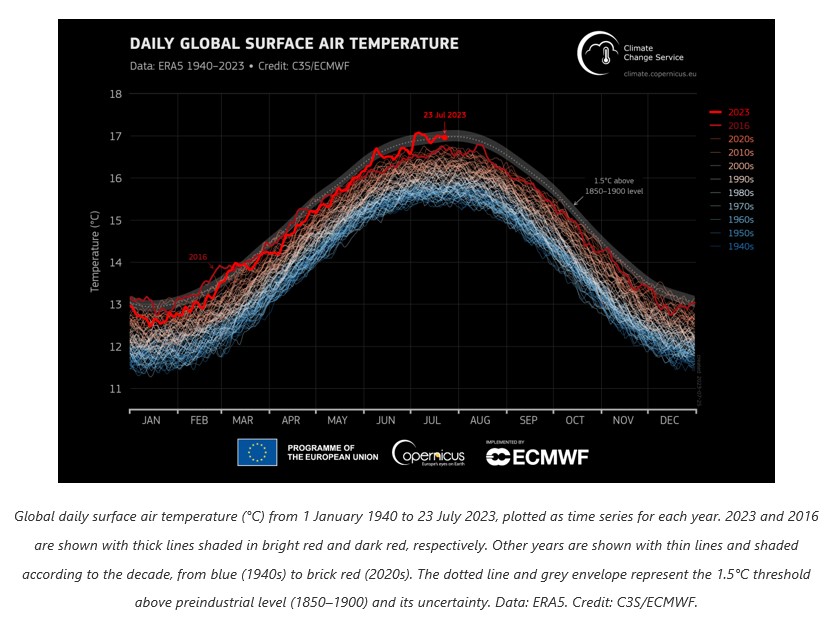
According to the ERA5 dataset, the global mean surface air temperature reached its highest daily value (17.08°C) on July 6, 2023. ERA5 is the fifth generation ECMWF (The European Centre for Medium-Range Weather Forecasts) atmospheric reanalysis of the global climate covering the period from January 1940 to the present. This value was within 0.01°C of the values recorded on July 5 and July 7. All days from July 3 till July 27 have been hotter than the previous record of 16.80°C from August 13, 2016.
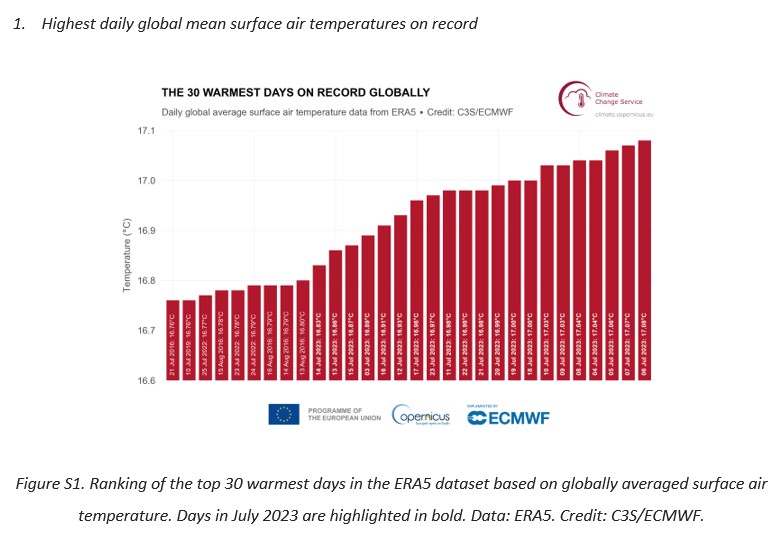
According to the ERA5 dataset, the global mean surface air temperature averaged for the first 23 days of July 2023 was 16.95°C. This is well above the 16.63°C recorded for the full month of July 2019.
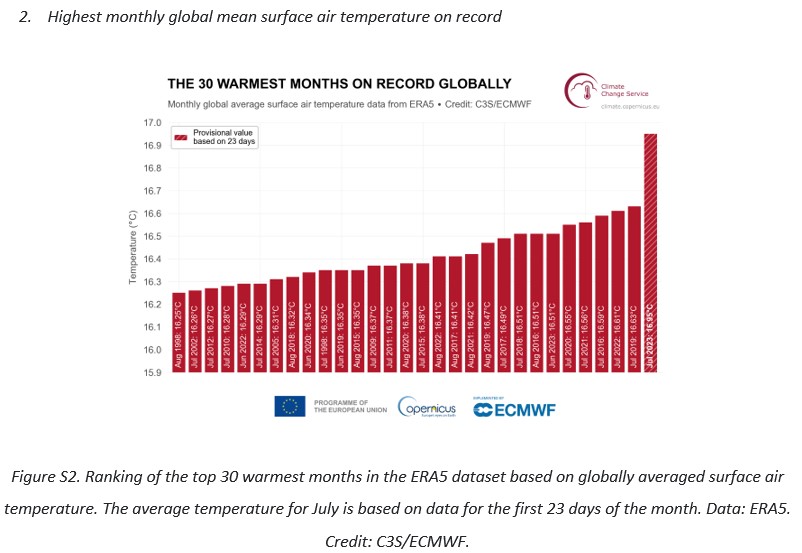
Climate change responsible for these records
Researchers are confident that fossil fuel emissions from anthropogenic activities are mostly to blame for the levels of warming we are now witnessing. According to the Intergovernmental Panel on Climate Change (IPCC), the UN’s climate science panel, human activity is responsible for the warming that has been experienced since the mid-19th Century. Fossil fuel use is the main factor driving global warming. In 2019, around 79% of global GHG emissions came from energy, industry, transport, and buildings, and 22% came from agriculture, forestry, and other land use. CO2 emissions reductions from efficiency measures are dwarfed by rising emissions in multiple sectors.
Global temperatures during the last decade were hotter than the previous warm period, around 6,500 years ago. The next most recent warm period, was about 125,000 years ago when the temperature range was 0.5°C-1.5°C hotter than temperatures before humans began warming the planet
“The extreme weather which has affected many millions of people in July is unfortunately the harsh reality of climate change and a foretaste of the future. The need to reduce greenhouse gas emissions is more urgent than ever before. Climate action is not a luxury but a must,” said Professor Petteri Taalas, Secretary-General, World Meteorological Organization.
Carlo Buontempo, Director of the Copernicus Climate Change Service (C3S) at ECMWF cited a similar opinion, “Record-breaking temperatures are part of the trend of drastic increases in global temperatures. Anthropogenic emissions are ultimately the main driver of these rising temperatures”.C
Besides global warming, there's the growing effect of El Niño in the Pacific Ocean, which is temporarily contributing to the warming of the atmosphere. It is a natural event that takes place every 5-7 years, which is linked with the warming of ocean waters and impacts the weather of almost the entire world. “Global surface temperatures have been exceptionally warm for the first three weeks of July, hovering around 1.5C above pre-industrial levels. This is driven by a combination of rapid global warming and by a strong El Nino event developing in the tropical Pacific. Years with El Nino events tend to be warmer than other years, but the inexorable march of temperatures upwards due to climate change is adding a permanent El Nino worth of heat to the Earth’s atmosphere every 5 to 10 years. July – like June before it – will almost certainly blow away the prior record for the month by a huge margin. The effects of the El Nino event developing this year will be felt even more strongly on global surface temperatures in 2024, so if the world sets a new record in 2023 it’s likely it will be quickly surpassed. The only way to stop the Earth from continuing to warm and extreme events associated with climate change from becoming more severe is to get global emissions of CO2 down to net-zero,” said Dr Zeke Hausfather, Research Scientist at Berkeley Earth.
What does it mean for India?
The increase in rainfall intensity and frequency of heatwaves are direct impacts of rising sea and surface temperatures. Climate change-led warming has made the Indian monsoon violent and erratic, furthering the risk of flooding through shifts in rainfall patterns. More warming has infused additional moisture into the atmosphere, leading to unprecedented weather events, such as in Northwest India. Not only has monsoon variability increased due to rising heat, but these events have become less predictable, posing another set of challenges.
“Monsoon rainfall patterns over India have seen a climatic shift in recent decades. The most significant change is that instead of having moderate rains spread out through the monsoon season, we have long dry periods intermittent with short spells of heavy rains. Hence this causes floods and droughts in the same season and occasionally in the same region or different parts of India. We saw this pattern manifesting during the current year also. Even though the all-India average rainfall is close to normal, the regional rainfall during the season so far came with deficits and floods. These erratic patterns in the monsoon have a huge impact on the agriculture in the country which is still largely rain-fed,” said Dr Roxy Mathew Koll, Climate Scientist at the Indian Institute of Tropical Meteorology and Lead IPCC Author.
He further added, “The pace of global warming is now accelerated and we need urgent action — as these extreme conditions will intensify in the near future. Climate action and adaptation at local (panchayat) levels should go parallel with mitigation at global and national levels. I am concerned that there is less focus on local adaptation. Instead of waiting for weather forecasts every year, we need to disaster-proof locally, based on sub-district wise assessment.”
“Climate change continues to increase Monsoon variability to another level with each passing year. There has been a steep rise in extremely heavy rain events, while the number of rainy days has reduced and dry-day periods have increased. Monsoon had made delayed onset, and progress was also sluggish, but that could not stop the extreme rain events in Assam, Himachal Pradesh, Uttarakhand, Delhi, and now Gujarat. Thus, the connection between climate change and extreme weather events has become stronger. Warming of oceans, especially the Arabian Sea and the Bay of Bengal has led to increased incursion of moisture in the atmosphere over India, especially over Indo-Gangetic Plains. This has increased the capacity of air to hold more moisture, leading to extremely heavy rainfall. In the warming world, these extreme rain events will become more often, especially during the Monsoon,” said Mahesh Palawat, Vice President- Meteorology and Climate Change, Skymet Weather.
Climate Action Now
Citing that “the era of global warming has ended” and “the era of global boiling has arrived,” United Nations Secretary-General António Guterres called for the need for global action on emissions, climate adaptation and climate finance. “Leaders must step up for climate action and climate justice, particularly those from the G20 leading industrial nations, responsible for 80 percent of global emissions. There should be new national emissions targets from G20 members and urged all countries to push to reach net zero emissions by mid-century. All actors must unite to accelerate the just and equitable transition from fossil fuels to renewable energy while stopping oil and gas expansion and phasing out coal by 2040.”
Leaders of the G20 nations met at the Environment and Climate Sustainability Ministerial in Chennai on July 27. They continued to discuss contentious issues such as climate change mitigation, adaptation and means of implementation or climate finance.
The COP28 President Dr. Sultan Al Jaber and the UNFCCC chief Simon Stiell on Thursday released a joint statement asking for accelerated action from the G20. The joint statement demands for tripling global renewable energy capacity and doubling the rate of energy efficiency improvements across sectors by 2030 and for G20 to drive strong outcomes towards COP28 and Global Stocktake.
The G20 energy ministerial which ended in Goa last week could not agree on a joint communique. Fractures between individual national priorities were clear from the language where the tripling of renewable energy, fossil fuel phasedown and mention of critical minerals was all diluted.


